By Eric Vandenbroeck
and co-workers
As China emerges this
month from the all-important 20th National Congress of the Chinese Communist
Party (CCP), its leadership will have to confront the most difficult set of
economic choices it has faced in decades. It can shift out of an economic
growth model that has generated a great deal of wealth, albeit at the cost of
growing inequality, surging debt, and an increasing amount of wasted investment
over the last decade. Or Beijing can continue with its current economic model
for a few more years until these rising costs force it into an even more
painful transition.
The problem facing
China is one that the German American economist Albert Hirschman described many
decades ago. All rapid growth is unbalanced growth, Hirschman noted, and a
successful development model is one in which unbalanced growth addresses and
reverses the existing imbalances in the economy. But as these are reversed and
the economy develops, the model becomes increasingly irrelevant to the
original imbalances and eventually creates a different set of problems.
Unfortunately,
Hirschman noted, abandoning a successful development model is a complex. Its
success tends to generate a set of deeply embedded political, business,
financial, and cultural institutions based on the continuance of the model, and
there is likely to be strong institutional and political opposition to any
substantial reversal.
Chinese
GDP Projection
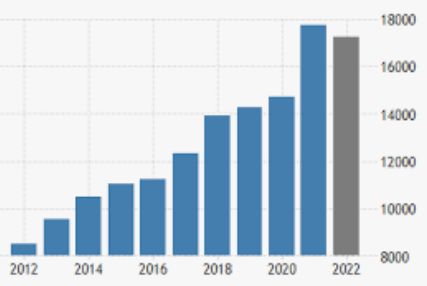
That’s where China finds
itself today. Its high-investment development
model was designed to resolve China’s extraordinary investment deficiency, but
nearly four decades later, it left China with an excessively high investment
rate. According to the World Bank, investment typically comprises around 25
percent of global GDP, ranging from 17 to 23 percent for more mature economies
to 28 to 32 percent for developing economies in their high-growth stages. For a
decade, however, China has invested an amount equal to 40 to 50 percent of its
annual GDP every year. It must reduce this unusually high level by a lot.
Still, growth so dependent on investment probably cannot do so without a sharp
slowdown in overall economic activity.
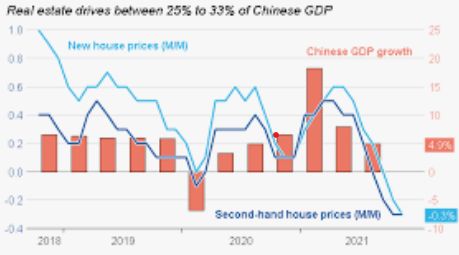
Deeper Into Debt
High investment rates
weren’t always a bad thing for China. The country was hugely underinvested in
infrastructure, logistics, and manufacturing capacity when it began its era of
“reform and opening up” in the late 1970s, after five decades that included war
with Japan, civil war, and Maoism. What it needed above all was a development
model that prioritized rapid investment.
The approach it took
over the next several years did just that. First, Beijing forced up the
domestic savings share of GDP needed to fund investment. In any economy,
everything produced that is not consumed is, by definition, saved, so forcing
up the savings share of GDP means forcing down the consumption share.
Beijing did this by
systemically constraining the growth of the household
share of GDP. A country’s total income is divided among households,
businesses, and the government, and households, unlike businesses and
government, consume most of what they earn. In practice, forcing down the
consumption share meant ensuring that businesses and government retained a
disproportionate share of what was produced and households a declining share.
The smaller the share households retain of GDP, the lower the consumption share
and the higher the savings share.
By the late 1990s,
the domestic savings share of GDP reached 50 percent, the highest level ever
recorded by any country. The banking system, China’s main intermediary for
savings, made these enormous savings available for Chinese businesses, property
developers, and local governments at artificially low, government-determined
interest rates. The consequence was rapid growth driven by high levels of
investment. That dynamic allowed China to close its underinvestment gap at an
astonishing pace.
But like every other
country that has followed a similar model, including the Soviet Union and
Brazil in the 1950s and 1960s and Japan in the 1970s and 1980s, China faced a
hidden trap. Once China closed the gap between its level of capital stock and
the level that its workers and businesses could productively absorb, it would
need to shift to a different growth strategy that de-emphasized investment in
favor of consumption. This gap was probably closed at least 15 years ago when
China’s debt burden rose rapidly.
This was not a
coincidence. Usually, when an economy channels large amounts of debt into
productive investment, the resulting rise in its GDP is likely to exceed the
rise in debt, and the country’s debt burden remains low. But when debt is used
to fund investments whose economic benefits are less than the cost of labor and
resources employed (known as “nonproductive investment”), debt rises faster
than GDP. China’s debt burden began to surge around
2006 to 2008.
Since then, China’s
official debt ratio has risen from roughly 150 percent to nearly 280 percent of
GDP–one of the fastest increases any country has ever experienced. The primary
sources of this rising debt burden were a private investment in China’s
property sector, including buildings filled with empty apartments that had been
purchased for speculative reasons, and investment by local governments in
excess infrastructure, such as overly ambitious rail systems, underutilized
roads and highways, and trophy stadiums and convention centers.
While the property
and infrastructure sectors had contributed so much to China’s economic activity
that they had become politically important to local elites, economic
policymakers became increasingly concerned that the only way they could regain
control of debt was by constraining nonproductive investment in these two
sectors. But with these accounting for over half of all Chinese GDP growth in
recent years–and a lot more than half during challenging periods for the
economy–it was almost impossible to constrain them without causing a sharp drop
in economic activity.
Bursting The Bubble
Regulators finally
took an essential first step in addressing the surge in debt last year when
they decided to clamp down on leverage by making it more difficult for the most
indebted property developers to borrow. For years, these developers had been in
a race to borrow as much as they could, not just from banks but also from
customers, suppliers, and contractors. They had used these funds to acquire as
much property as possible, and as long as real estate prices could be counted
on to rise forever, they took little credit risk and were always able to sell
at a profit.
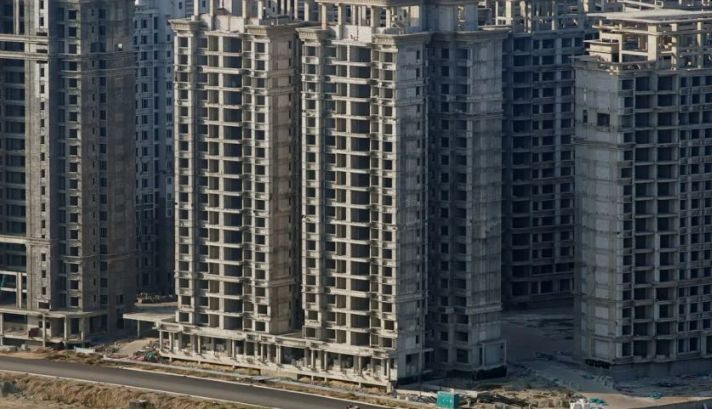
But with the property
sector accounting for 20 to 30 percent of all economic activity, it was
inevitable that any sharp contraction in real
estate would quickly become self-reinforcing and lead to a substantial–and very
unwelcome–slowdown in economic activity. What was perhaps unexpected after last
year’s clampdown on the property sector’s borrowing was how financial distress
spread to other parts of the economy. This was especially true for local
governments, for which land sales comprised the largest single source of
revenues; households suddenly began to worry that prices wouldn’t rise
indefinitely, and businesses were directly and indirectly affected by
insolvency in the property sector.
With growing concerns about the pace of China’s economic
slowdown, Beijing can respond only in limited ways. One option is to return to
the days of rapid, debt-fueled growth, either by attempting to revive the
property sector or make up for its decline by significantly increasing spending
on infrastructure. Local governments have been eager, almost desperate, to
revive the property market, but it may be too late for that if homebuyers’ expectations that home prices in
China can keep rising have been permanently punctured.
Moreover, Beijing
officials seem very reluctant to return to the old ways of doing business in which
developers took on enormous amounts of debt to finance speculative new
projects. With Chinese residential real estate priced at roughly three times
the comparable level in the United States and with the property sector
representing such an extraordinarily high share of total economic activity,
most economic policymakers have long wanted to see the market cool down.
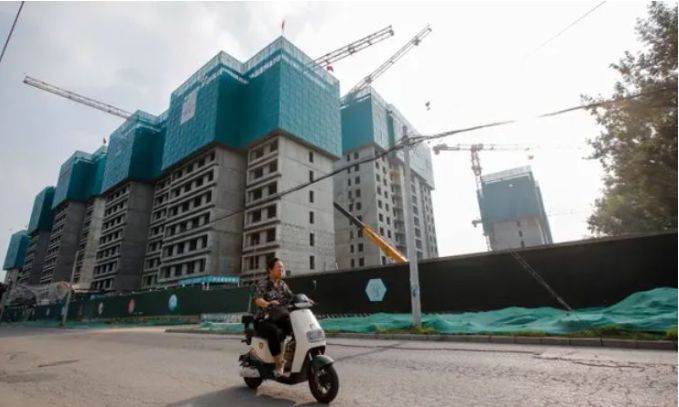
More likely is that
the Chinese government will compensate for the adverse impact of a slower and
smaller property market, at least partly, by stepping up spending on
infrastructure. Beijing already seems willing to follow this path and has told
local governments to accelerate or increase their infrastructure spending
plans.
But building more
bridges and high-speed railway systems still means allowing growth to be driven
mainly by nonproductive investment, as it has been during the past decade. This
will cause China’s debt burden to rise and resources to be misallocated until
the economy can no longer sustain the consequences. In previous cases, the
result has usually been a very disruptive adjustment, often in the form of
a financial crisis akin to Brazil’s in the early 1980s.
The second option for
Beijing is to maintain high growth by rebalancing the economy increasingly
toward consumption. Beijing has been trying to do this since at least 2007, but
an increase in consumer spending requires increasing the share households
retain of GDP. Ordinary people, in other words, would have to receive a larger
share of what the economy produces in the form of higher wages, stronger
pensions, more welfare benefits, and so on, and this would have to be paid for
by Beijing and local governments by giving up some of their share of GDP.
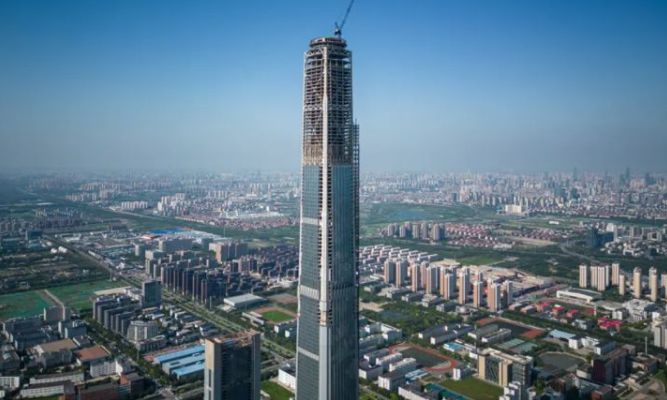
Such an adjustment is
tough to accomplish politically. The distribution of political power in
China, as in any country, is partly the consequence of the distribution of
economic power, and a significant shift in the latter would almost certainly
set off a commensurate shift in the former. That doesn’t mean it cannot happen,
but so far, there is no evidence that China will manage a rebalancing of the
distribution of income than other countries.
The second option for
Beijing is to maintain high growth by rebalancing the economy increasingly
toward consumption. Beijing has been trying to do this since at least 2007, but
an increase in consumer spending requires increasing the share households
retain of GDP. Ordinary people, in other words, would have to receive a larger
share of what the economy produces in the form of higher wages, more vital
pensions, more welfare benefits, and so on, and this would have to be paid for
by Beijing and local governments by giving up some of their share of GDP.
Such an adjustment is
tough to accomplish politically. The distribution of political power in China,
as in any country, is partly the consequence of the distribution of economic
power. A significant shift in the latter would almost certainly set off a
commensurate shift in the former. That doesn’t mean it cannot happen. Still, so
far, there is no evidence that China will manage a rebalancing of the
distribution of income that other countries with similar problems have
been unable to achieve.
Finally, suppose
Beijing is determined to act now to control the unsustainable increase in debt
and cannot rebalance the economy. In that case, the third option is simply for
Beijing to allow GDP growth rates to fall sharply, probably to below three (or
even two) percent. If handled correctly, most of the cost of this decline will
fall on the government sector and not on households, so this won’t matter too much
to ordinary people. Still, it does mean slower growth for the Chinese economy
overall and especially in the state apparatus.

After almost three
decades with the highest investment share of GDP in history, too much of
China’s investment is directed, by necessity, to projects that create economic
activity (and debt) but that does not create real economic value. That is why
it is unlikely that China can continue to invest anywhere near the same amount
every year.
In that case, China’s
only options are to bring down investment rapidly and accept the consequences
of much lower growth or to maintain high levels of growth by forcing continued
high rates of investment until the resulting surge in its debt burden makes it
difficult or impossible to stay on that path. One way or another, in other
words, Chinese growth will slow sharply, and how it does will have profound
consequences for the country, the CCP, and the global economy.
For updates click hompage here